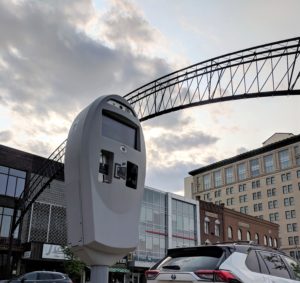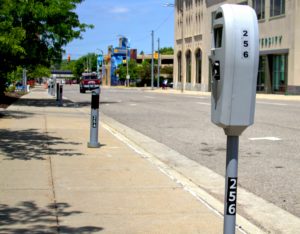By Paul Rozycki
As the bricks on Saginaw Street are being redone to give us a smoother ride downtown, perhaps it is time to reconsider what happens when that ride is done. Where to park the car?
For almost the last four years, Municipal Parking Services has been running the Flint parking system. It is a private firm that shares the parking revenue with the Downtown Development Authority.

It has installed meters with remote sensors and pay stations that were designed to make parking, and paying for parking, more efficient in our computer age. Drivers were asked to park in designated areas, go to a pay station with either coins or credit/debit cards, and pay for their parking time. Rates are $1 per hour with a two-hour limit. Those who don’t pay, or otherwise violate policy, would have their license plates scanned and receive a $25 fine in the mail.
The current parking system in downtown Flint
In Elizabeth Ireland-Curtis’ article in this month’s East Village Magazine, she outlines the many details of the current parking system in the downtown and its connection to the Downtown Development Authority. In 2019, Flint was the first community to use this automated technology with the Flint AutoPark system.

Downtown Flint parking meter (Photo by Paul Rozycki)
As Ireland-Curtis indicates, though the current system provides income for both the company and the DDA, it also presents a number of problems for both those who wish to park downtown and those businesses who want to see more customers downtown. Many have begun to question the wisdom of the current arrangement for both the city and the downtown.
Many avoid the meters and downtown
The automated system all seems very smooth and efficient, but because of many complaints about tickets, inoperative meters, other errors, or simple confusion, many go out of their way to avoid the meters, doing business either after five or on weekends, parking blocks away, or staying away from the downtown altogether. Many complain that even a brief stop in a parking area results in a fine. None of that serves the Flint downtown or its business well.

Saginaw Street downtown Flint. (Photo by Tom Travis)
For a city that is called the Vehicle City, it’s easy to forget how important parking is to the automotive culture of the last century and the impact it can have on downtowns. In the 1960s, as shopping malls popped up on the edges to cities, they often sucked the business out of downtown and into the newly built malls. Anyone who was in Flint when Genesee Valley Mall (and others) opened in 1970 can recall the impact on downtown as vacancy after vacancy appeared in the storefronts.
Why did that happen? Parking.
Downtowns either had limited parking or costly parking, and the malls had acres of free parking spaces. It was easier for shoppers to go to the mall, knowing they could find a parking place, rather than scramble for a place on the downtown street.
An invisible but powerful issue
Though it is something we rarely think about until we are searching for a parking place, parking is, and has long been, a powerful issue.
A few years ago I was writing the history of Mott Community College, and looking over the old student newspapers, I discovered one complaint that remained unchanged over the decades. It was parking. As early as the 1930s students were complaining about parking problems on campus, and that frustration continued in one form or another in the 1940s, 1950s, 1960s, 1970s, and beyond. Perhaps only the recent pandemic and the move to more virtual classes has limited the complaints.
Parking is also an emotional issue — and even a violent one. Some recent shootings have taken place over parking place conflicts.
Parking rates around Michigan and the nation
How cities have handled the parking issue varies. Some are free. Some are very costly.
Nationwide, New York has the most expensive street parking, averaging $20 an hour. Chicago is second with an average of $19 for the same time.
On the other hand, Sycamore, Illinois, a small town near where I grew up, about an hour west of Chicago, takes pride in the fact that it still has parking meters that take pennies.
In 2018, according to the Detroit Free Press, the Michigan cities of Northville, Clawson, Berkley and Plymouth were all free, with certain hour limits. Detroit and Rochester charge $1 an hour for their meters. Ann Arbor is higher at $1.60, Birmingham and Royal Oak are $1.50, Grosse Pointe and Mt. Clemens are 75 cents an hour, and Ferndale is 50 cents. Grand Rapids varies from $1 to $2.25 and Lansing rates are from 75 cents to $1.50.
The impact of parking
Beyond the issue of parking in Flint and other Michigan cities, some are taking a look at the role parking and the automobile play in our environment and our whole society. In a recently published book by Henry Grabar, titled “Paved paradise: How parking explains the world” the author argues that the efforts to find parking spaces for our cars has diverted resources from other more desirable goals and made our cities less livable and uglier. He generally supports the idea that parking in large urban areas should reflect the real cost of providing parking spaces and that the higher costs would make for less auto traffic, more public transportation and a cleaner environment.
What should Flint do?
A move to wide-spread public transportation and downtown malls may be a stretch for cities the size of Flint. But there clearly is a problem with our downtown parking. It’s true that it does generate some income for the DDA, but is it worth it if it dives away visitors and downtown businesses lose customers?

Street parking on Harrison Street downtown Flint (Photo by Tom Travis)
Are there other ways of generating the same income? Are there better ways to provide the public with secure and affordable parking in downtown? Whether we opt for a free parking system or a paid system, at the very least it should be dependable and reliable, and citizens should not be afraid they will get a ticket every time they drive down the bricks and slip into a parking place. As we replace the bricks on Saginaw Street maybe it’s also a time to park the meters.

EVM Political commentator Paul Rozycki
EVM political commentator and board president Paul Rozycki can be reached at paul.rozycki@mcc.edu.


You must be logged in to post a comment.